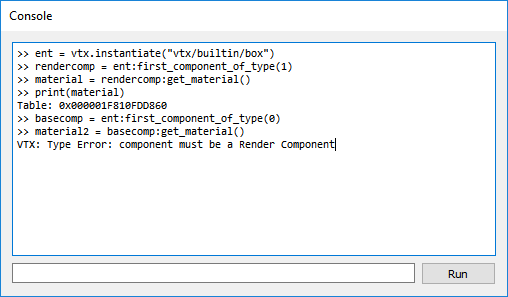Component Introspection
This week, work on the scripting interface continued. As the image below shows, I can now access an entity’s components and even drill down to its Material through the Lua console.

The image above shows an example of the scripting interface for entities and components. Here, we are creating a new Entity from the builtin Box primitive and then finding its first component of type “1”. Type 1 is an alias to the Render Component of the Entity. It is responsible for binding a Mesh and a Material together.
Once we have the Render Component, we use it to access its Material property and print its memory address.
As the image shows, although Lua allows for very flexible duck typing, I am performing type checking behind the scenes to make scripting mistakes obvious to the user. Allow me to elaborate:
For the interface, I’ve decided that all components will be hidden behind the vtx.Component “class”. Now, this class will be responsible to exposing the interface to all native component methods, such as get_material(), set_mesh(), get_transform() and so forth.
The problem is, how do we prevent trying to access the material property of a Component that doesn’t have one, such as the Md2AnimationComponent? In my mind, there are two ways. I’m going to call them the “JavaScript” way and the “Python” way.
In the JavaScript way, we don’t really care. We allow calling any method on any component and silently fail when a mismatch is detected. We may return nil or “undefined”, but at no point are we raising an error.
In the Python way, we will perform a sanity check before actually invoking the function on the component, and actually halt the operation when an error is found. You can see that in the example above. Here we’re purposefully attempting to get the material of a Base Component (component type 0), which doesn’t have one. In this case, the Engine detects the inconsistency and raises an error.
I feel the Python way is the way to go to prevent subtle hard-to-debug errors arising from allowing any method to be called on any component and happily carrying on through to -hopefully- reach some sort of result.
A third alternative would have been to actually expose a separate “class” for every component type. This would certainly work, but I’m concerned about a potential “class explosion”, as we continue to add more and more components to the Engine. Furthermore, I feel strongly typed duck typing is a good approach, well in tune with the language philosophy, for a language like Lua.
Now that we can drill all the way down to an Entity’s material, it’s time to expand the interface to allow setting the shader and the material properties, allowing the script developer to control how entities are rendered by the Engine. Stay tuned for more!